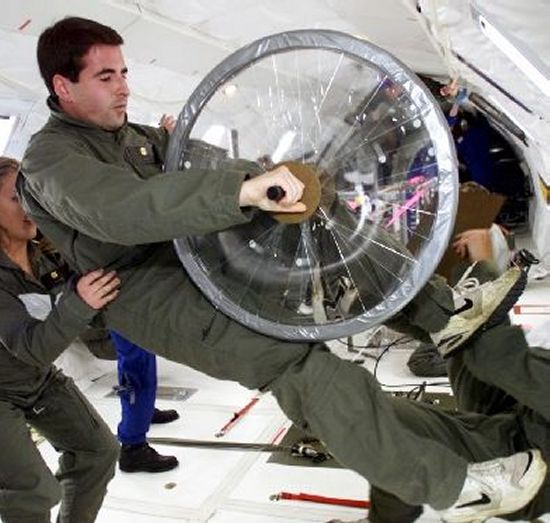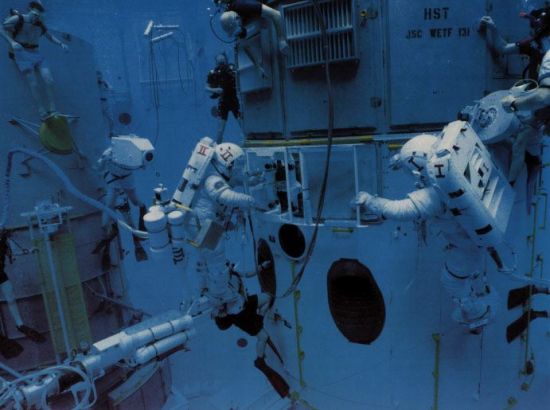|
||||||||||
|
|
||||||||||
|
||||||||||
|
|
||||||||||

NASA typically selects a new group of astronaut trainees about every two years. Most classes only contain 15 members or so, but the exact size depends on NASA's needs. The photo above shows the class of 1996, which was probably one of the largest ever, given the need for new astronauts to operate the International Space Station. The process for making these selections takes about nine months. The deadline for submitting an application is July 1 of odd-numbered years. These applications are reviewed by the Astronaut Candidate Selection Rating Panel to decide which ones are highly qualified applicants. Upon further review, only a portion of these highly qualified applicants are chosen for week-long interviews and medical examinations. The final selections are publicly announced the following spring. The new astronaut candidates report to Johnson Space Center in Houston during the summer to begin training.
Most of those selected have gained a significant amount of experience before joining the program. Experience as a military test pilot is particularly common. Others selected for astronaut training are often experts in some scientific or technical field that is of use to the research NASA plans to conduct. I recommend that you take a look through the NASA astronaut biographies to get a better understanding of the backgrounds of those selected to become astronauts.
NASA divides the astronaut positions into three basic categories: Pilot Astronauts (or Commander/Pilot Astronauts), Mission Specialist Astronauts, and Payload Specialist Astronauts. Additional details on each kind of astronaut and the requirements specific to each are provided below.
The Pilot astronaut includes both pilots and commanders. The commander is responsible for the overall operation of a spacecraft, like the Space Shuttle, during flight. The pilot's primary duty is to control the flight of the vehicle, particularly during liftoff and reentry. An astronaut typically must have flown at least one mission as pilot before becoming a commander.
A Pilot astronaut must have at least a bachelor's degree from an accredited institution in a technical field, which includes engineering, biological science, physical science, or mathematics. An advanced master's or doctorate degree is preferred. The applicant must also have at least 1,000 hours of flight experience as pilot in jet-powered aircraft. Experience as a test pilot is also highly desirable. It is for this reason that nearly all Pilot astronauts are former military pilots, especially military test pilots.
Pilots astronauts must also meet certain physical requirements. The applicant must pass a NASA Class I physical. Among the requirements for such a physical are 20/100 or better uncorrected vision that is correctable to 20/20 in each eye. In addition, blood pressure must be no higher than 140/90 when in a sitting position. The applicant must also have a height no less than 5 ft, 4 in (1.62 m) and no greater than 6 ft, 4 in (1.93 m). Pilot astronauts must be US citizens.
Mission Specialist Astronaut
Mission specialists have responsibility over a particular aspect of a given mission, such as the operation of a specific piece of equipment or the conduct of a particular experiment. Among the duties a mission specialist might perform are extravehicular activities (EVAs), or space walks, and operation of the remote manipulator system. Mission specialists may also be responsible for payloads and specific scientific experiments.
Requirements for mission specialists are generally similar to those for pilot candidates. Mission specialists must also hold at least a bachelor's degree in a technical field. However, they must also have at least three years of related, progressively responsible, professional experience. An advanced degree is highly desirable and may be substituted as experience. A master's degree is considered equal to one year of experience while a doctoral degree can be substituted for three years of experience.
Mission specialist candidates must pass a NASA Class II physical. The physical requirements include 20/200 or better uncorrected vision, correctable to 20/20. Blood pressure must also meet the 140/90 requirement, and a mission specialist must be between 4 ft, 10.5 in (1.48 m) and 6 ft, 4 in (1.93 m). Mission specialists must be US citizens.
Payload Specialist Astronaut
The term payload specialist is essentially a catch-all for other astronauts that do not fall into the categories described above. Payload specialists are not actually employed by NASA, but are flown aboard NASA spacecraft for specific missions. A typical payload specialist possesses knowledge and experience required to operate a particular, unique payload carried during a mission. The specialists train with their NASA crewmates, but do not remain with NASA once the mission is concluded. Payload specialists typically represent commercial, educational, scientific, or international institutions. Other payload specialists have included "celebrity passengers" like Sen. John Glenn.

It should also be noted that federal law prohibits NASA from specifying age requirements in selecting astronauts, but most are between the ages of 26 and 46. The average age of a candidate is about 35. NASA also maintains affirmative action programs to ensure that minority groups are represented in the astronaut corp.
However, being selected for the program does not automatically mean that you are an astronaut. Those selected are considered astronaut candidates, and a candidate typically undergoes one to two years of training before officially becoming an astronaut. The final selection of an astronaut depends on successful completion of the training and evaluation period. After successfully completing this period, a civilian astronaut is expected to remain in the program for at least five years. A military astronaut remains a member of the military who is detailed to NASA for a tour of duty, the length of which may vary.
The first sequence of training is primarily classroom courses to familiarize the students with the systems and basic sciences they will be working with. The subjects covered include shuttle systems, mathematics, geology, meteorology, guidance and navigation, oceanography, orbital dynamics, astronomy, physics, and materials processing. Astronaut candidates are also given training in land and sea survival, scuba diving, and space suits. Other training includes flights aboard NASA's Reduced Gravity Research Aircraft, affectionately known as the "Vomit Comet," to introduce candidates to the effects of weightlessness. Trainees also must maintain flying proficiency using NASA's T-38 jet trainers and the Shuttle Training Aircraft that simulates landing the Orbiter.

Training becomes more rigorous once the astronaut begins focusing more on Space Shuttle operations. This phase of training begins by studying manuals and computerized lessons before proceeding to simulators. The Single System Trainer familiarizes astronauts with the operations of each Orbiter subsystem while the Shuttle Mission Simulators provide training on each stage of flight. Once assigned to a specific mission, the training becomes more specialized and includes the actual software to be used during the flight. The astronauts also train with flight controllers in mission control. The total time spent training in the simulators for a specific mission is about 300 hours.

Additional training is done in a neutral buoyancy water tank facility that simulates the environment of space. This training is particularly useful for mission specialists prior to conducting space walks. Mission specialists also train in Shuttle mockups containing payload bay workstations. These stations allow the specialists to practice operating the manipulator arm and other payload bay equipment. Pilots receive about 100 hours of training aboard the Shuttle Training Aircraft and make about 600 simulated Orbiter approaches.
Finally, let's discuss Bradley's question about whether joining the Air Force improves one's chances of becoming an
astronaut. While we have pointed out that military pilots do have some distinct advantages in being selected, the
military route is a double-edged sword. For example, most of the military pilots selected as Pilot Astronauts had
previously been test pilots. Becoming a test pilot is nearly as difficult as becoming an astronaut, and only
a relatively few military officers are selected for test pilot training. In addition, active duty military
personnel do not apply directly to NASA, but to astronaut selection boards within the services themselves. These offices have their own
screening processes to determine which candidates will be recommended to NASA for further consideration. Military
officers, therefore, have to go through one and more likely two highly competitive layers of selection that
civilian applicants need not worry about.
- answer by Greg Alexander, 30 May 2004
Read More Articles:


|
Aircraft | Design | Ask Us | Shop | Search |

|
|
| About Us | Contact Us | Copyright © 1997-2023 | |||
|
|
|||